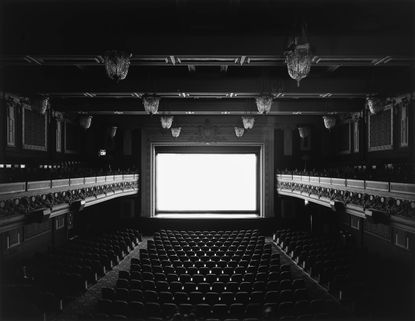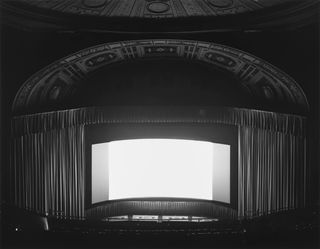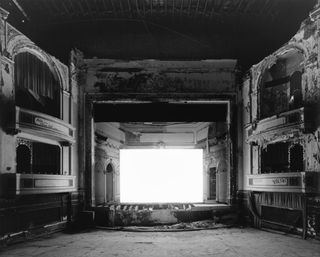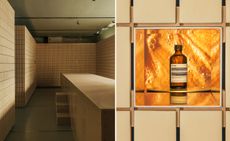Screen idol: Hiroshi Sugimoto’s serene series of theatres is worth looking up to

It takes a rare sort of curiosity to devote a lifetime to a single project. But it was this ‘sense of vocation’ that spurred Japanese photographer Hiroshi Sugimoto to capture theatres around the world for nearly four decades.
Sugimoto began work on his Theaters series when he was just 28 years old. Forty years later, he finds himself revisiting his earlier photographs – and by extension, his younger self – for a new book celebrating this body of work, published by Damiani Editore in collaboration with Matsumoto Editions.
Using a large-format camera and no light source other than the projection of the running movie, Sugimoto captures an entire film in one starkly serene still. Each full-length feature film renders as a brilliantly luminous white box, gently coaxing out the architectural details of each space in the artist's characteristically masterful use of monochrome.

UA Rivoli, New York, 1977
‘I wanted to photograph a movie, with all its appearance of life and motion, in order to stop it again,’ the artist explains in the book’s foreword. ‘My dream was to capture 170,000 photographs on a single frame of film. The image I had inside my brain was of a gleaming white screen inside a dark movie theatre.’
The book, too, is worthy in its own right as a fascinating and simply beautiful catalogue of theatre architecture. Sugimoto leads with classic American movie palaces built in the 1920s and 30s. Ornate and stoically majestic, they embody the pinnacle of Hollywood's Golden Age. The 1990s saw the artist cruising through drive-ins; IMAX screens dominate later, strangely alien and imposing in their scale.
More recently, Sugimoto has circled back to the film industry’s romantic prime, capturing historic theatres in Europe as well as turning his lens on abandoned venues. He imagines the works to ‘be the embodiment or manifestation of something awe-inspiring and divine’. Certainly, the artist’s heavenly interpretation of these architectural spaces is worth looking up to.

Goshen, Indiana, 1980

Everett Square Theater, Boston, 2015
INFORMATION
Theaters, by Hiroshi Sugimoto, $60, published by Damiani Editore/Matsumoto Editions. For more information, visit Hiroshi Sugimoto’s website
Wallpaper* Newsletter
Receive our daily digest of inspiration, escapism and design stories from around the world direct to your inbox
-
 Inside Valentino’s glamorous new Sloane Street store, inspired by the art of haute couture
Inside Valentino’s glamorous new Sloane Street store, inspired by the art of haute coutureThe latest in Valentino’s ‘The New Maison’ store concept opens on London’s Sloane Street this week, offering an enveloping marble and carpet-clad space of ‘intimacy and uniqueness’
By Jack Moss Published
-
 Aesop’s Salone del Mobile 2024 installations in Milan are multisensory experiences
Aesop’s Salone del Mobile 2024 installations in Milan are multisensory experiencesAesop has partnered with Salone del Mobile to launch a series of installations across Milan, tapping into sight, touch, taste, and scent
By Hannah Tindle Published
-
 Dial into the Boring Phone and more smartphone alternatives
Dial into the Boring Phone and more smartphone alternativesFrom the deliberately dull new Boring Phone to Honor’s latest hook-up with Porsche, a host of new devices that do the phone thing slightly differently
By Jonathan Bell Published
-
 ‘Package Holiday 1968-1985’: a very British love affair in pictures
‘Package Holiday 1968-1985’: a very British love affair in pictures‘Package Holiday’ recalls tans, table tennis and Technicolor in Trevor Clark’s wistful snaps of sun-seeking Brits
By Caragh McKay Published
-
 ‘Art Exposed’: Julian Spalding on everything that’s wrong with the art world
‘Art Exposed’: Julian Spalding on everything that’s wrong with the art worldIn ‘Art Exposed’, Julian Spalding draws on his 40 years in the art world – as a museum director, curator, and critic – for his series of essays
By Alfred Tong Published
-
 Marisol Mendez's ‘Madre’ unpicks the woven threads of Bolivian womanhood
Marisol Mendez's ‘Madre’ unpicks the woven threads of Bolivian womanhoodFrom ancestry to protest, how Marisol Mendez’s 'Madre' is rewriting the narrative of Bolivian womanhood
By Sofia de la Cruz Published
-
 Hiroshi Sugimoto reflects on time and truth ahead of his London retrospective
Hiroshi Sugimoto reflects on time and truth ahead of his London retrospectiveAs ‘Hiroshi Sugimoto: Time Machine’ opens at Hayward Gallery, the artist tells us of his guiding force, and why his Seascapes always end up in the bedroom
By Danielle Demetriou Published
-
 Photo book explores the messy, magical mundanity of new motherhood
Photo book explores the messy, magical mundanity of new motherhood‘Sorry I Gave Birth I Disappeared But Now I’m Back’ by photographer Andi Galdi Vinko explores new motherhood in all its messy, beautiful reality
By Hannah Silver Published
-
 Remote Antarctica research base now houses a striking new art installation
Remote Antarctica research base now houses a striking new art installationIn Antarctica, Kyiv-based architecture studio Balbek Bureau has unveiled ‘Home. Memories’, a poignant art installation at the remote, penguin-inhabited Vernadsky Research Base
By Harriet Lloyd-Smith Published
-
 Best contemporary art books: a guide for 2023
Best contemporary art books: a guide for 2023From maverick memoirs to topical tomes, turn over a new leaf with the Wallpaper* arts desk’s pick of new releases and all-time favourite art books
By Harriet Lloyd-Smith Published
-
 The best photography books for your coffee table
The best photography books for your coffee tableFlick through, mull over and deep-dive into the best photography books on the market, from our shelves to you
By Sophie Gladstone Published